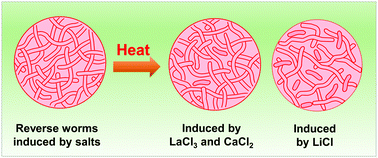Correlations between temperature-dependent rheology and electrostatic interactions in reverse wormlike micelles induced by inorganic salts†
Abstract
Previous studies have shown that the plateau modulus Gp of the wormlike micelles formed in water driven by hydrophobic interactions is a constant upon heating, similar to polymer solutions, and Gp of the reverse worms formed in oils driven by hydrogen bonding decreases with increasing temperature. In this work, we investigated the reverse worms induced by three chloride salts that bind lecithin through different strengths of electrostatic interactions, in the order of LaCl3 > CaCl2 > LiCl. We correlated the interaction strengths with the temperature-dependent rheological properties and found that upon heating, Gp for all the reverse worms driven by electrostatic interactions decays slower than that driven by the weak temperature-sensitive hydrogen bonding. Furthermore, the decay rates of Gp follow an order in the inverse relation to the interaction strength, LaCl3 ≤ CaCl2 < LiCl, indicating that the dependence of Gp on temperature can reflect the strength of the driving forces for micellization. We utilized Fourier transform infrared spectroscopy (FTIR) to confirm the weakening of the interaction and the small angle X-ray scattering (SAXS) technique to reveal the decrease in the lengths of the reverse worms as temperature increases, both of which echo the changes in the rheological properties.



 Please wait while we load your content...
Please wait while we load your content...